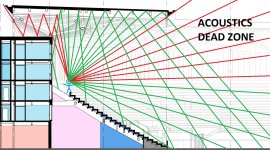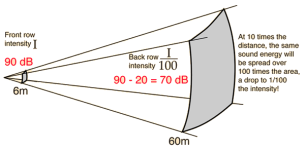OUFCwaffle
Well-known member
- Joined
- 7 Dec 2017
- Messages
- 2,532
1) Introduction
I've been doing a science experiment for the purpose of verifying what I was told during the fans forum regarding the placement of safe standing for home fans. From the fans forum I quote (not word for word but thereabouts), "the north stand would be the better placement due to the negative pitch on the roof compared to the south stand with a positive pitch, leading to sound being reflected down rather than pushed up and out".
2) Methodology
The model was conducted using my high end acoustics modelling software that is Microsoft Paint.
The model shows two key areas. The first being the audibility zone (shown in green) where sound is heard either directly from the source, or by reflection off a surface. The second being the dead zone (shown in red) where sound is lost out of the stadium.
I have modelled it based on the highest row of supporters for that area (shown by the blue stick man). This represents the best possible acoustics profile for that particular area. As the rows descend, the dead zone widens and the audibility zone narrows.
3) Limitations
-This is only showing a 2D cross-section, there will be additional reverberations off other surfaces that are not shown.
-The roof height varies along the width of both stands, so this only shows the profile of the centreline of the stand, directly behind the goal.
-Reflection lines are only approximately drawn, and are for indication only and cannot be used to accurately quantify sound levels at various points.
-It is assuming a maximum sound cone of approximately 160° from the source.
4) Findings
Figure 1 shows a dead zone with a maximum angle of approximately 30° and a further 10° dead zone at the rear of the stand.
So of the 160° sound cone, 25% of the total noise generated is lost.
Of the audible zone, 30° of the cone is projected directly on to the pitch from the source, and only approximately 10° of the noise will be reflected off the roof onto the pitch, the rest will be reflected back into the stand. This means that of the total noise generated, only 25% of it will be audible on the pitch. The sound reflected off the roof will be concentrated to within 20 yards of the goal line.
Figure 1 - North stand acoustics model best case

Figure 2 shows a dead zone with a maximum angle of approximately 15° and a further 10° dead zone at the rear of the stand.
So of the 160° sound cone, 15% of the total noise generated is lost.
Of the audible zone, 35° of the cone is projected directly on to the pitch from the source, and 30° of the noise will be reflected off the roof onto the pitch, the rest will be reflected back into the stand. This means that of the total noise generated, 40% of it will be audible on the pitch. The sound reflected off the roof will be broadly spread out over the pitch up to the halfway line.
Figure 2 - South stand acoustics model best case

5) Conclusions
-The north stand has a maximum audibility of 75%, compared to the south stand with an audibility of 85%, a 10% reduction in total noise generated within the stadium.
-The north stand has a maximum pitch reflection of approximately 20 yards, compared to the south stand with approximately 60 yards of pitch reflection. This means that for the remaining 40 yards of pitch, the south stand will generate twice the level of noise of the north stand.
-The north stand could be louder closer to the goal than the south stand due to the roof pitch, but the south stand will be louder over the whole pitch.
-The loss of 4 rows of seating at the top of the north stand will mean 15% less noise will be generated from that stand compared to the south stand.
-The audible noise level of the north stand will at best comparable to the east stand at the Kassam Stadium, if not worse.
-The statement given by the club "the north stand would be the better placement due to the negative pitch on the roof compared to the south stand with a positive pitch, leading to sound being reflected down rather than pushed up and out" is not correct and clearly misinformed.
-Home fans will have to be much louder than away fans to generate the same level of noise, which will mean it will be potentially harder to create a loud home atmosphere than if they had put safe standing in the south stand.
6) Recommendations
-The club should conduct a thorough acoustics review to more accurately quantify the figures given in this study to help inform their decision making.
-The club should explore safe standing across the whole of the south stand, as this will arguably be the loudest area of the stadium.
-Alternatively, keep the safe standing in the north stand, but extend the roof out further. This will reduce the acoustic dead zone and increase the amount of noise reflected down on to the pitch.
7) Final thoughts
It is disappointing that acoustics have been neglected by the club when designing the stadium. Generating the loudest possible home atmosphere is key to improving match day experience and boosting performances on the pitch.
I've been doing a science experiment for the purpose of verifying what I was told during the fans forum regarding the placement of safe standing for home fans. From the fans forum I quote (not word for word but thereabouts), "the north stand would be the better placement due to the negative pitch on the roof compared to the south stand with a positive pitch, leading to sound being reflected down rather than pushed up and out".
2) Methodology
The model was conducted using my high end acoustics modelling software that is Microsoft Paint.
The model shows two key areas. The first being the audibility zone (shown in green) where sound is heard either directly from the source, or by reflection off a surface. The second being the dead zone (shown in red) where sound is lost out of the stadium.
I have modelled it based on the highest row of supporters for that area (shown by the blue stick man). This represents the best possible acoustics profile for that particular area. As the rows descend, the dead zone widens and the audibility zone narrows.
3) Limitations
-This is only showing a 2D cross-section, there will be additional reverberations off other surfaces that are not shown.
-The roof height varies along the width of both stands, so this only shows the profile of the centreline of the stand, directly behind the goal.
-Reflection lines are only approximately drawn, and are for indication only and cannot be used to accurately quantify sound levels at various points.
-It is assuming a maximum sound cone of approximately 160° from the source.
4) Findings
Figure 1 shows a dead zone with a maximum angle of approximately 30° and a further 10° dead zone at the rear of the stand.
So of the 160° sound cone, 25% of the total noise generated is lost.
Of the audible zone, 30° of the cone is projected directly on to the pitch from the source, and only approximately 10° of the noise will be reflected off the roof onto the pitch, the rest will be reflected back into the stand. This means that of the total noise generated, only 25% of it will be audible on the pitch. The sound reflected off the roof will be concentrated to within 20 yards of the goal line.
Figure 1 - North stand acoustics model best case

Figure 2 shows a dead zone with a maximum angle of approximately 15° and a further 10° dead zone at the rear of the stand.
So of the 160° sound cone, 15% of the total noise generated is lost.
Of the audible zone, 35° of the cone is projected directly on to the pitch from the source, and 30° of the noise will be reflected off the roof onto the pitch, the rest will be reflected back into the stand. This means that of the total noise generated, 40% of it will be audible on the pitch. The sound reflected off the roof will be broadly spread out over the pitch up to the halfway line.
Figure 2 - South stand acoustics model best case

5) Conclusions
-The north stand has a maximum audibility of 75%, compared to the south stand with an audibility of 85%, a 10% reduction in total noise generated within the stadium.
-The north stand has a maximum pitch reflection of approximately 20 yards, compared to the south stand with approximately 60 yards of pitch reflection. This means that for the remaining 40 yards of pitch, the south stand will generate twice the level of noise of the north stand.
-The north stand could be louder closer to the goal than the south stand due to the roof pitch, but the south stand will be louder over the whole pitch.
-The loss of 4 rows of seating at the top of the north stand will mean 15% less noise will be generated from that stand compared to the south stand.
-The audible noise level of the north stand will at best comparable to the east stand at the Kassam Stadium, if not worse.
-The statement given by the club "the north stand would be the better placement due to the negative pitch on the roof compared to the south stand with a positive pitch, leading to sound being reflected down rather than pushed up and out" is not correct and clearly misinformed.
-Home fans will have to be much louder than away fans to generate the same level of noise, which will mean it will be potentially harder to create a loud home atmosphere than if they had put safe standing in the south stand.
6) Recommendations
-The club should conduct a thorough acoustics review to more accurately quantify the figures given in this study to help inform their decision making.
-The club should explore safe standing across the whole of the south stand, as this will arguably be the loudest area of the stadium.
-Alternatively, keep the safe standing in the north stand, but extend the roof out further. This will reduce the acoustic dead zone and increase the amount of noise reflected down on to the pitch.
7) Final thoughts
It is disappointing that acoustics have been neglected by the club when designing the stadium. Generating the loudest possible home atmosphere is key to improving match day experience and boosting performances on the pitch.
Last edited:

